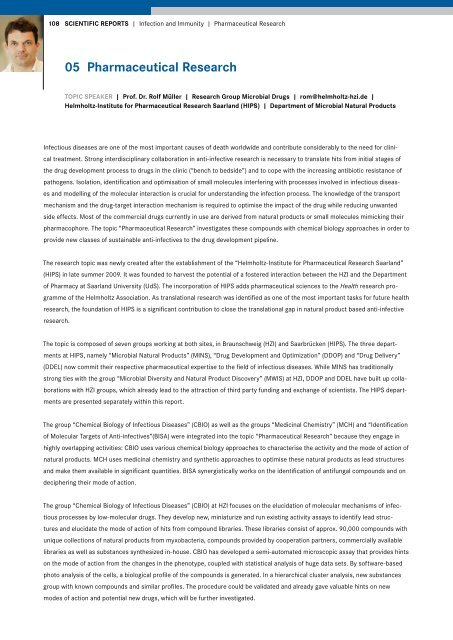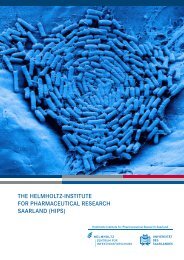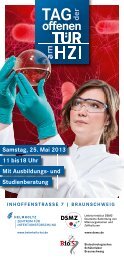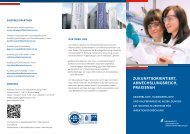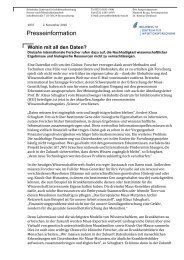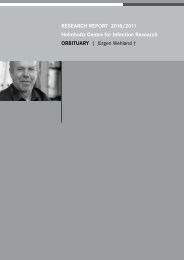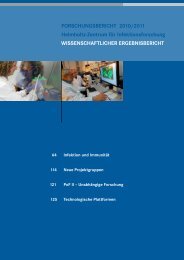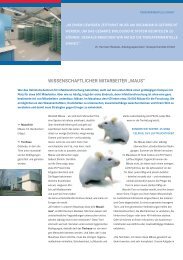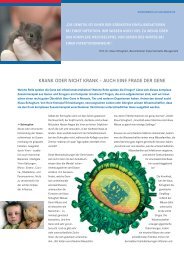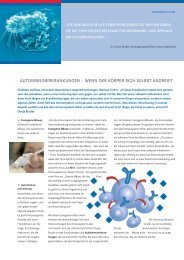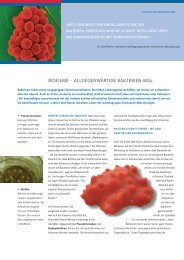Research Report 2010 2011 - Helmholtz-Zentrum für ...
Research Report 2010 2011 - Helmholtz-Zentrum für ...
Research Report 2010 2011 - Helmholtz-Zentrum für ...
You also want an ePaper? Increase the reach of your titles
YUMPU automatically turns print PDFs into web optimized ePapers that Google loves.
108 SCIENTIFIC REPORTS | Infection and Immunity | Pharmaceutical <strong>Research</strong><br />
05 Pharmaceutical <strong>Research</strong><br />
TOPIC SPEAKER | Prof. Dr. Rolf Müller | <strong>Research</strong> Group Microbial Drugs | rom@helmholtz-hzi.de |<br />
<strong>Helmholtz</strong>-Institute for Pharmaceutical <strong>Research</strong> Saarland (HIPS) | Department of Microbial Natural Products<br />
Infectious diseases are one of the most important causes of death worldwide and contribute considerably to the need for clinical<br />
treatment. Strong interdisciplinary collaboration in anti-infective research is necessary to translate hits from initial stages of<br />
the drug development process to drugs in the clinic (“bench to bedside”) and to cope with the increasing antibiotic resistance of<br />
pathogens. Isolation, identifi cation and optimisation of small molecules interfering with processes involved in infectious diseases<br />
and modelling of the molecular interaction is crucial for understanding the infection process. The knowledge of the transport<br />
mechanism and the drug-target interaction mechanism is required to optimise the impact of the drug while reducing unwanted<br />
side effects. Most of the commercial drugs currently in use are derived from natural products or small molecules mimicking their<br />
pharmacophore. The topic “Pharmaceutical <strong>Research</strong>” investigates these compounds with chemical biology approaches in order to<br />
provide new classes of sustainable anti-infectives to the drug development pipeline.<br />
The research topic was newly created after the establishment of the “<strong>Helmholtz</strong>-Institute for Pharmaceutical <strong>Research</strong> Saarland”<br />
(HIPS) in late summer 2009. It was founded to harvest the potential of a fostered interaction between the HZI and the Department<br />
of Pharmacy at Saarland University (UdS). The incorporation of HIPS adds pharmaceutical sciences to the Health research programme<br />
of the <strong>Helmholtz</strong> Association. As translational research was identifi ed as one of the most important tasks for future health<br />
research, the foundation of HIPS is a signifi cant contribution to close the translational gap in natural product based anti-infective<br />
research.<br />
The topic is composed of seven groups working at both sites, in Braunschweig (HZI) and Saarbrücken (HIPS). The three departments<br />
at HIPS, namely “Microbial Natural Products” (MINS), “Drug Development and Optimization” (DDOP) and “Drug Delivery”<br />
(DDEL) now commit their respective pharmaceutical expertise to the fi eld of infectious diseases. While MINS has traditionally<br />
strong ties with the group “Microbial Diversity and Natural Product Discovery” (MWIS) at HZI, DDOP and DDEL have built up collaborations<br />
with HZI groups, which already lead to the attraction of third party funding and exchange of scientists. The HIPS departments<br />
are presented separately within this report.<br />
The group “Chemical Biology of Infectious Diseases” (CBIO) as well as the groups “Medicinal Chemistry” (MCH) and “Identifi cation<br />
of Molecular Targets of Anti-infectives”(BISA) were integrated into the topic “Pharmaceutical <strong>Research</strong>” because they engage in<br />
highly overlapping activities: CBIO uses various chemical biology approaches to characterise the activity and the mode of action of<br />
natural products. MCH uses medicinal chemistry and synthetic approaches to optimise these natural products as lead structures<br />
and make them available in signifi cant quantities. BISA synergistically works on the identifi cation of antifungal compounds and on<br />
deciphering their mode of action.<br />
The group “Chemical Biology of Infectious Diseases” (CBIO) at HZI focuses on the elucidation of molecular mechanisms of infectious<br />
processes by low-molecular drugs. They develop new, miniaturize and run existing activity assays to identify lead structures<br />
and elucidate the mode of action of hits from compound libraries. These libraries consist of approx. 90,000 compounds with<br />
unique collections of natural products from myxobacteria, compounds provided by cooperation partners, commercially available<br />
libraries as well as substances synthesized in-house. CBIO has developed a semi-automated microscopic assay that provides hints<br />
on the mode of action from the changes in the phenotype, coupled with statistical analysis of huge data sets. By software-based<br />
photo analysis of the cells, a biological profi le of the compounds is generated. In a hierarchical cluster analysis, new substances<br />
group with known compounds and similar profi les. The procedure could be validated and already gave valuable hints on new<br />
modes of action and potential new drugs, which will be further investigated.


